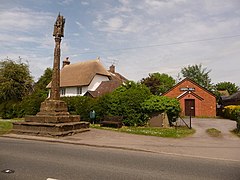Shillingstone
| Shillingstone | |
|---|---|
 Gospel Hall and cross, Shillingstone |
|
| Shillingstone shown within Dorset | |
| Population | 1,170 |
| District | |
| Shire county | |
| Region | |
| Country | England |
| Sovereign state | United Kingdom |
| Post town | BLANDFORD FORUM |
| Postcode district | DT11 |
| Dialling code | 01258 |
| Police | Dorset |
| Fire | Dorset and Wiltshire |
| Ambulance | South Western |
| EU Parliament | South West England |
| UK Parliament | |
| Website | http://www.shillingstone.info |
Shillingstone /ˈʃɪlᵻŋstən/ is a village and civil parish in the Blackmore Vale area of north Dorset, England, situated on the River Stour between Sturminster Newton and Blandford Forum. In the 2011 census the civil parish had 479 households and a population of 1,170.
Shillingstone features in the Domesday Book of 1086 as a settlement of 46 households, with meadow, woodlands and a mill, under the lordship of Ascelin. Its name is a derivation of Eschelling's (or Ascelin's) town. It once had the tallest maypole in Dorset - 86 feet high. An agricultural community, it specialised in the production of moss.
In the first World War, it earned the title, "the bravest village in Britain", because of the high proportion of residents who volunteered to join the armed forces. In 1924 the Shillingstone lime works was started to extract lime from the chalk beds at Shillingstone Hill.
Shillingstone Parish Council meets monthly to discuss planning applications, maintenance of allotments and the local recreation ground, and other local amenities.
The parish church of the Holy Rood is a short distance away from the village and is of 12th-century origin, constructed in banded flint and ashlar masonry. It was enlarged in the 15th century and in the 19th century; G. F. Bodley added the north aisle. The font is of the 12th century and the pulpit of the 17th. The hymn writer Edward Dayman was appointed Rector of Shillingstone in 1842. About 150m south of the church is a medieval cross base.
...
Wikipedia

